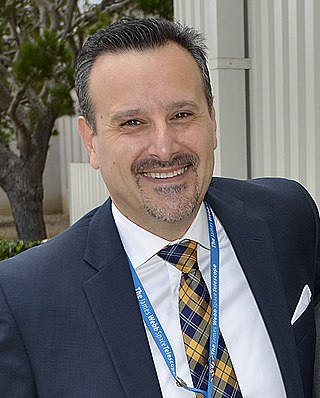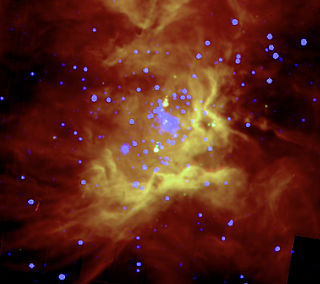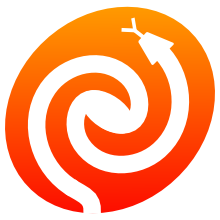Flexible Image Transport System (FITS) is an open standard defining a digital file format useful for storage, transmission and processing of data: formatted as multi-dimensional arrays, or tables. FITS is the most commonly used digital file format in astronomy. The FITS standard was designed specifically for astronomical data, and includes provisions such as describing photometric and spatial calibration information, together with image origin metadata.
The SAO/NASA Astrophysics Data System (ADS) is an online database of over 16 million astronomy and physics papers from both peer reviewed and non-peer reviewed sources. Abstracts are available free online for almost all articles, and full scanned articles are available in Graphics Interchange Format (GIF) and Portable Document Format (PDF) for older articles. It was developed by the National Aeronautics and Space Administration (NASA), and is managed by the Smithsonian Astrophysical Observatory.

IRAF is a collection of software written at the National Optical Astronomy Observatory (NOAO) geared towards the reduction of astronomical images and spectra in pixel array form. This is primarily data taken from imaging array detectors such as CCDs. It is available for all major operating systems for mainframes and desktop computers. IRAF was designed cross-platform, supporting VMS and UNIX-like operating systems. Use on Microsoft Windows was made possible by Cygwin in earlier versions, and can be today done with the Windows Subsystem for Linux. Today, it is primarily used on macOS and Linux.

The Giant Metrewave Radio Telescope (GMRT), located near Narayangaon, Pune in India, is an array of thirty fully steerable parabolic radio telescopes of 45 metre diameter, observing at metre wavelengths. It is the largest and most sensitive radio telescope array in the world at low frequencies. It is operated by the National Centre for Radio Astrophysics (NCRA), a part of the Tata Institute of Fundamental Research, Mumbai. It was conceived and built under the direction of Late Prof. Govind Swarup during 1984 to 1996. It is an interferometric array with baselines of up to 25 kilometres (16 mi). It was recently upgraded with new receivers, after which it is also known as the upgraded Giant Metrewave Radio Telescope (uGMRT).

The GNU Data Language (GDL) is a free alternative to IDL, achieving full compatibility with IDL 7 and partial compatibility with IDL 8. Together with its library routines, GDL is developed to serve as a tool for data analysis and visualization in such disciplines as astronomy, geosciences, and medical imaging. GDL is licensed under the GPL. Other open-source numerical data analysis tools similar to GDL include Julia, Jupyter Notebook, GNU Octave, NCAR Command Language (NCL), Perl Data Language (PDL), R, Scilab, SciPy, and Yorick.

The Starlink Project, referred to by users as Starlink and by developers as simply The Project, was a UK astronomical computing project which supplied general-purpose data reduction software. Until the late 1990s, it also supplied computing hardware and system administration personnel to UK astronomical institutes. In the former respect, it was analogous to the US IRAF project.

Gamma Delphini, which is Latinized from γ Delphini, is a wide binary star system in the northern constellation of Delphinus. The star marks one corner of the asterism "Job's Coffin". The pair can be split with a modest amateur telescope and have been described as "one of the prettier pairs in the sky", with their contrasting colors said to be orange and lime in appearance. Together, the system is visible to the naked eye with a combined apparent visual magnitude of 3.87.

Llano de Chajnantor Observatory is the name for a group of astronomical observatories located at an altitude of over 4,800 m (15,700 ft) in the Atacama Desert of northern Chile. The site is in the Antofagasta Region approximately 50 kilometres (31 mi) east of the town of San Pedro de Atacama. The exceptionally arid climate of the area is inhospitable to humans, but creates an excellent location for millimeter, submillimeter, and mid-infrared astronomy. This is because water vapour absorbs and attenuates submillimetre radiation. Llano de Chajnantor is home to the largest and most expensive astronomical telescope project in the world, the Atacama Large Millimeter Array (ALMA). Llano de Chajnantor and the surrounding area has been designated as the Chajnantor Science Reserve by the government of Chile.
Kenneth Irwin Kellermann is an American astronomer at the National Radio Astronomy Observatory. He is best known for his work on quasars. He won the Helen B. Warner Prize for Astronomy of the American Astronomical Society in 1971, and the Bruce Medal of the Astronomical Society of the Pacific in 2014.
Astronomical Image Processing System++ is a software package whose development was started in the early nineties, written almost entirely in C++, and which initial goal was to replace the by then already aging AIPS software. It has now been reborn as CASA and is the basis of the image processing systems for several next-generation radio telescopes including ALMA, eVLA, and ASKAP.

NGC 5307 is a planetary nebula in the southern constellation of Centaurus, positioned less than 3° to the northeast of the star Epsilon Centauri. It was discovered by English astronomer John Herschel on April 15, 1836. The nebula is located at a distance of approximately 10.6 kilolight-years from the Sun. The central star, designated PNG 312.3+10.5, is a weak emission-line star, superficially similar to the WC subtype of Wolf–Rayet stars. It has a spectral class of O(H)3.5 V.

Alberto Conti, is an astrophysicist and the Vice President and General Manager of the Civil Space Strategic Business Unit (SBU) at Ball Aerospace. He is one of the creators of the GoogleSky concept, of the idea of astronomical outreach at South by SouthWest 2013 and of the James Webb Space Telescope iBook. He is also the Executive Producer of the Emmy Winning CNN Films The Hunt for Planet B.

Astroinformatics is an interdisciplinary field of study involving the combination of astronomy, data science, machine learning, informatics, and information/communications technologies. The field is closely related to astrostatistics.

Roger Llewelyn Davies is a British astronomer and cosmologist, one of the so-called Seven Samurai collaboration who discovered an apparent concentration of mass in the Universe called the Great Attractor. He is the Philip Wetton Professor of Astrophysics at Oxford University. His research interests centre on cosmology and how galaxies form and evolve. He has a longstanding interest in astronomical instruments and telescopes and developed the scientific case for the UK's involvement in the 8m Gemini telescopes project. He has pioneered the use of a new class of astronomical spectrograph to measure the masses and ages of galaxies, as well as search for black holes in their nuclei. He is the founding Director of the Oxford Centre for Astrophysical Surveys which is funded by the Hintze Family Charitable Foundation.

HEALPix, an acronym for Hierarchical Equal Area isoLatitude Pixelisation of a 2-sphere, is an algorithm for pixelisation of the 2-sphere and the associated class of map projections. The pixelisation algorithm was devised in 1997 by Krzysztof M. Górski at the Theoretical Astrophysics Center in Copenhagen, Denmark, and first published as a preprint in 1998.

Astronomy and Computing is a peer-reviewed scientific journal covering research on applications computer science in astronomy published by Elsevier. It was established in 2013 and is abstracted and indexed in the Astrophysics Data System, INSPEC and Scopus. The current editor-in-chief is Fabio Pasian.
The Astrophysics Source Code Library (ASCL) is an online registry of scientist-written software used in astronomy or astrophysics research. The primary objective of the ASCL is to make the software used in research available for examination to improve the transparency of research.

RCW 36 is an emission nebula containing an open cluster in the constellation Vela. This H II region is part of a larger-scale star-forming complex known as the Vela Molecular Ridge (VMR), a collection of molecular clouds in the Milky Way that contain multiple sites of ongoing star-formation activity. The VMR is made up of several distinct clouds, and RCW 36 is embedded in the VMR Cloud C.

NGC 127 is a lenticular galaxy that was discovered on November 4, 1850, by Bindon Stoney, the same day he discovered NGC 126 and NGC 130. NGC 127 is a gas-rich, star-forming galaxy showing emission lines. It is an interacting companion to the peculiar, edge-on galaxy NGC 128, and the pair are connected by a bridge of material. The south-east part of NGC 127 is asymmetrical in the direction of NGC 128. It may have recently passed the more massive NGC 128, from which an infall of gas is flowing onto NGC 127.

Jonathan (Joss) Bland-Hawthorn is a British-Australian astrophysicist. He is a Laureate professor of physics at the University of Sydney, and director of the Sydney Institute for Astronomy.















